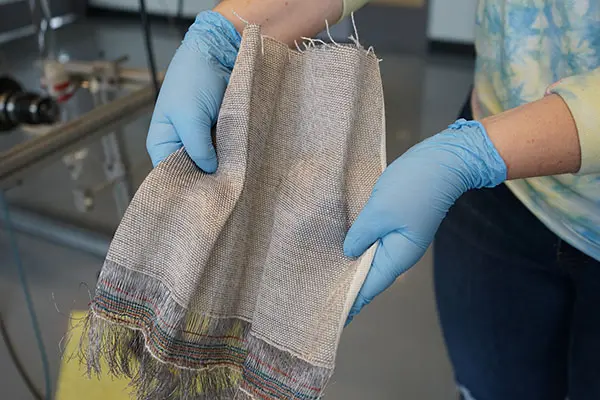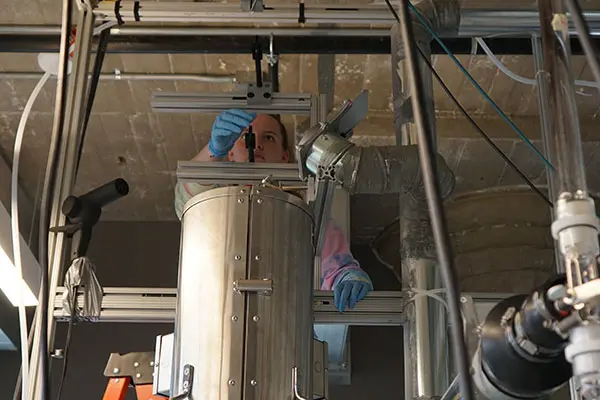Solar, Sensing and Flame-Retardant Technologies Also Have Civilian Applications

10/08/2019
By Katharine Webster
University and Army researchers are taking advantage of the UMass Lowell Fabric Discovery Center to make and test fabric that can act as a portable solar panel, passively collecting energy that can power sensors or charge mobile phones, two-way radios and other electronic devices.
The technology could help firefighters who operate in the wilderness for days at a time, as well as soldiers in the field, says Plastics Engineering Prof. Ramaswamy Nagarajan, co-director of Harnessing Emerging Research Opportunities to Empower Soldiers, or HEROES – a research and development collaboration between UMass Lowell and the U.S. Army Combat Capabilities Development Command (CCDC) Soldier Center in Natick.
“This fabric is very robust. You can bend it, and it’s breathable,” Nagarajan says. “We’re going to integrate the fabric into uniforms and tents so people can charge their communication devices.”
“Soldiers have to carry 18 pounds just in batteries to support the electronics they use in the field,” adds Sid Iyer, a senior plastics engineering major and Honors College student working on the project. “We’re trying to replace some of the batteries with solar fabric to reduce that weight.”
The solar fabric is just one of several HEROES research projects on greener and smarter fabrics intended to benefit the military – for example, using natural materials to create stable dyes and inexpensive flame retardants for use in uniforms. The technology has civilian applications, too: Fabrics that include printed sensors could potentially be used to test the integrity of both soldiers’ helmets and structures such as bridges and airplane wings
The solar fabric research project is based on technology developed by other UML researchers a decade ago. Physics Prof. Jayant Kumar from the Center for Advanced Materials; Claire Lepont, who worked on photovoltaics at a former UML spinoff; and Ravi Mosurkal, an Army scientist, have improved on the earlier technology. They have also custom-designed a machine to produce the photovoltaic fibers at the Fabric Discovery Center, which is located in the university’s Innovation Hub building at 110 Canal St. in downtown Lowell.
The machine first coats a thin stainless-steel wire with multiple photosensitive layers and then wraps another wire around it, creating the positive and negative electrodes. Next, the coated and wrapped wire is encapsulated in a transparent epoxy to protect it. A special loom in the Fabric Discovery Center partly automates the fabric weaving process, combining photovoltaic fibers with regular cotton to create a sturdy but flexible fabric.
The research received early support from commercial partners including Protect the Force, EMD, Textech and Saunders Electronics, and it is currently funded by a $200,000 U.S. Department of Homeland Security grant awarded to Protect the Force and the university.
Under another grant funded by the CCDC Soldier Center, the researchers are also experimenting with modifying the materials and configuration for greater efficiency and stability. The next step is to use robotics to connect the electrodes in the individual fibers to “buzz bars,” or terminals, to create a power source.

Flame retardants came into widespread use a half-century ago due to the risk of fires involving synthetic polymer fabrics, such as polyester, that were used in products ranging from children’s sleepwear to upholstery. Some of the flame retardants are highly toxic because they contain halogens, including chlorine and bromine. That’s a serious public health issue, Nagarajan says. “You’re in contact with them a lot, and so we’re seeing them show up in blood, urine, breast milk and other places,” he says.
Finding natural alternatives with low toxicity is a high priority for the fabric industry, and the research on flame retardants was initially funded by the Toxics Use Reduction Institute at UML. It’s also a high priority for the military due to the number of burn injuries suffered by soldiers in recent conflicts, especially in Iraq, Nagarajan says. Currently, the CCDC Soldier Center is funding the research on flame retardants.
While Kevlar or Nomex don’t burn easily, they are very expensive, and so most military uniforms are made of a nylon-cotton blend, Nagarajan says. The combination of tannic and phytic acids, coated on top of that fabric, doesn’t burn; it chars instead, and the char forms a protective layer that prevents oxygen and flame from spreading rapidly through the fabric. The next challenge is figuring out if it’s possible to maintain the coating’s effectiveness through 50 or more launderings, he says.
Nagarajan, Mosurkal and Alex Morgan, a research scientist at the University of Dayton and an expert in flame retardants, are working to develop the technology for possible commercial use with partners in industry, including Triton Systems Inc.
Nagarajan has previously done research on fabrics and polymer films printed with sensors that can be incorporated into structures and read wirelessly to determine if the structure is warping, cracking or stretching. His research group developed some custom inks for printing these sensors, including a low-temperature silver ink that can be applied to films and fabrics without distorting them.
Nagarajan says that HEROES has more than 90 ongoing research projects designed to help the military by creating and applying advanced materials that are also more sustainable and less toxic for humans and the environment. “Nature knows how to get rid of these materials because they occur in nature – as long as we don’t alter them too much,” he says.
